Biology MCQs with answers for NEET Post Fertilisation Structures Endosperm Embryo and Seed
Question 1. Which one of the following events takes place after double fertilisation?
- The pollen grain germinates on the stigma
- The pollen tubes enter the embryo sac
- Two male gametes are discharged into the embryo sac
- The PEN (Primary Endosperm Nucleus) develops into endosperm
- The male gamete fuses with egg to form a zygote
Answer: 4. The PEN (Primary Endosperm Nucleus) develops into endosperm
After double fertilisation, endosperm development precedes embryo development. The primary
endosperm cell divides repeatedly and forms a triploid endosperm tissue.
Read And Learn More: NEET Biology Multiple Choice Question And Answers
Question2. The real function of the ‘endosperm’ is to
- Supply nutrition to the growing embryo
- Form integuments of ovule
- Form funicle of ovule
- None of the above
Answer: 1. Supply nutrition to the growing embryo
Endosperm is a part of a seed that acts as a food store for the developing embryo of plants. It is formed by the triple fusion of the primary endosperm nucleus during double fertilisation.
Question 3. If the number of chromosomes in egg cell is 8, then what is the number of chromosomes in endosperm?
- 24
- 8
- 16
- 12
Answer: 1. 24
Egg cell is haploid, whereas endosperm is triploid as it is formed by the fusion of one male gamete with two polar nuclei. Therefore, the number of chromosomes in endosperm will be 8×3=24.
Question 4. How many chromosomes are there in endosperm cell of Zea mays?
- Fourty
- Twenty
- Thirty
- Ten
Answer: 3. Thirty
Endosperm is triploid in maize. In maize, 2n = 20. So, number of chromosomes in endosperm of maize (Zea mays) will be = 3n = 3 × 10 = 30.
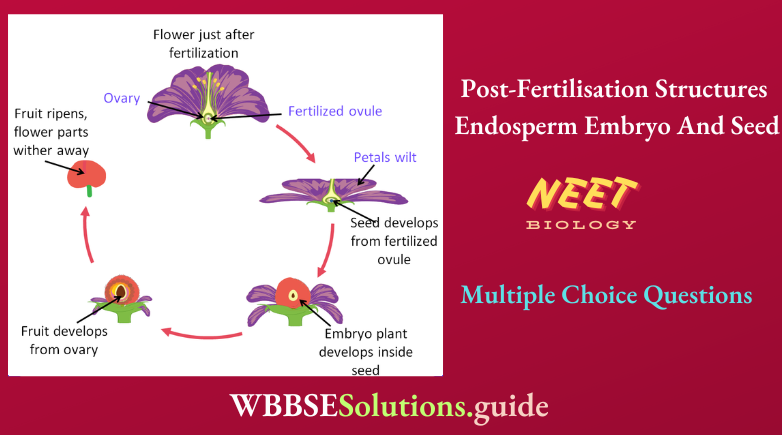
Question 5. Which of the following has haploid endosperm?
- Wheat
- Maize
- Gymnosperms
- Castor
Answer: 3. Gymnosperms
Endosperm of gymnosperm is haploid (ploidy n). It develops from megaspore (n) before fertilisation and forms a continuation of the female
gametophyte.
Question 6. A diploid female plant and a tetraploid male plant are crossed. The ploidy of endosperm shall be
- Tetraploid
- Triploid
- Diploid
- Pentaploid
Answer: 1. Tetraploid
- When the male plant is tetraploid, the gamete formed after meiotic division will be diploid. The female plant is diploid as a result, the gamete formed after the meiotic division will be haploid.
- The endosperm cell is formed by the fusion of two polar nuclei and one male gamete. The two polar nuclei mean 2n and one male gamete will be 2n which fuses to form tetraploid endosperm.
Question 7. The diploid endosperm is found in
- Pepromia
- Solanum
- Triticum
- Oenothera
Answer: 4. Oenothera
- Oenothera contains monosporic type of embryo sac. It possesses an egg apparatus with a uninucleate central cell.
- The uninucleate central cell fuses with male gamete to form diploid endosperm. This endosperm is genetically identical to the embryo.
Biology MCQs with answers for NEET
Question 8. In gymnosperms, the endosperm is formed by
- Fertilised egg
- Germination of one megaspore
- Fusion of two polar nuclei
- Fusion of one polar nucleus
Answer: 2. Germination of one megaspore
In gymnosperms, the endosperm is formed in the ovule during germination of the one megaspore. It consequently becomes the female prothallus (gametophyte), with a haploid set of chromosomes.
Question 9. Conifers differ from grasses in the
- Formation of endosperm before fertilisation
- Production of seeds from ovules
- lack of xylem tracheids
- Absence of pollen tubes
Answer: 1. Formation of endosperm before fertilisation
- Conifers differ from grasses in the formation of endosperm before fertilisation. Conifers are the most primitive of the seed plants.
- A seed comprises two parts, i.e. an endosperm, which nourishes the embryo and the embryo itself, which
is fed by the endosperm. In gymnosperms, the endosperm grows from a spore. - Pollination may occur when the cone is small, but the endosperm continues to grow to completion before fertilisation occurs. When fully grown, the endosperm develops archegonia in which single large nuclei act as egg cells.
Question 10. Free nuclear divisions in the life cycle of angiosperms can be traced in
- Cellular endosperm
- Nuclear endosperm
- Helobial endosperm
- Both 2 and 3
Answer: 4. Both 2 and 3
- In nuclear endosperm formation, repeated free nuclear divisions take place. If a cell wall is formed, it will form after free nuclear divisions, e.g. coconut water.
- In helobial endosperm formation, a cell wall is laid down between the first two nuclei after which one half develops endosperm along the cellular pattern and the other half along nuclear pattern.
Question 11. Which of the following statements is incorrect about nuclear endosperm?
- Common type of endosperm
- Cytokinesis takes place
- Freely suspended triploid nuclei are formed in cytoplasm
- It is observed in maize, rice, and wheat
Answer: 2. Cytokinesis takes place
Statement in option is incorrect and can be corrected as In nuclear endosperm, nucleus divides to form many nuclei, but cytokinesis does not take place. Rest statements are correct about nuclear endosperm.
Helobial Endosperm
Question 12. The endosperm nucleus gives rise to a number of free nuclei which remain in the peripheral layer of embryo sac cytoplasm surrounding a large central vacuole in case of
- Cocos
- Capsella bursa-pastoris
- Date palm
- All of the above
Answer: 4. All of the above
All given options possess nuclear endosperm. The endosperm nucleus gives rise to a number of free nuclei which remain in the peripheral layer of embryo sac cytoplasm surrounding a large central vacuole. The cytoplasm thickens so that the vacuole decreases in size.
Question 13. In cellular type of endosperm,
- Every division of primary endosperm is followed by cytokinesis
- Endosperm development occurs in cellular form
- Balsam and Petunia show cellular type of endosperm
- All of the above
Answer: 4. All of the above
- In cellular type of endosperm development, cytokinesis occurs after each nuclear division of endosperm nucleus.
- The endosperm, thus has a cellular form from the very beginning because subsequent divisions are all accompanied by wall formation, e.g. Petunia, Datura, Adoxa, balsam, etc.
Thus, option is 4. correct.
Question 14. Formation of liquid endosperm in coconut takes place because
- Karyokinesis is not followed by cytokinesis
- Karyoki nesis is followed by cytokinesis
- Formation of liquid endosperm is not dependent upon karyokinesis and cytokinesis
- None of the above
Answer: 1. Karyokinesis is not followed by cytokinesis
During the early development of liquid endosperm in coconut fruits, nuclei divide repeatedly before cytokinesis sets in. In this, karyokinesis is not followed by cytokinesis.
Biology MCQs with answers for NEET
Question 15. Select the correct order of endosperm types.
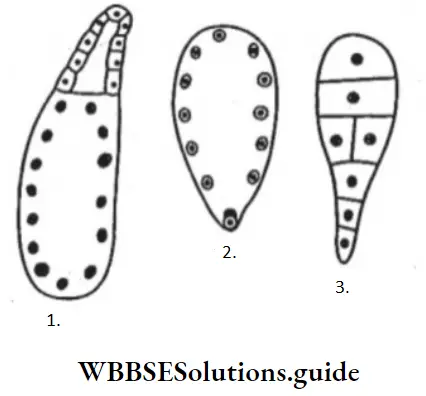
- A–Cellular, B–Helobial, C–Free nuclear
- A–Cellular, B–Free nuclear, C–Helobial
- A–Helobial, B–Free nuclear, C–Cellular
- A–Free nuclear, B–Cellular, C–Helobial
- A–Free nuclear, B–Helobial, C–Cellular
Answer: 3. A–Helobial, B–Free nuclear, C–Cellular
Question 16. In ………….. families, the product of double fertilisation soon disintegrates and endosperm development is completely absent.
- Orchidaceae and Podostemaceae
- Asteraceae and Fabaceae
- Poaceae and Brassicaceae
- All of the above
Answer: 1. Orchidaceae and Podostemaceae
There are at least two families– Orchidaceae and Podostemaceae, where the product of double fertilisation soon disintegrates and endosperm development is completely absent.
Biology MCQs with answers for NEET
Question 17. ‘Ruminate endosperm’ is found in UP
- Cruciferae
- Asteraceae
- Euphorbiaceae
- Annonaceae
Answer: 4. Annonaceae
- Ruminate endosperm is a special type of endosperm where the surface of the endosperm is uneven, i.e. having ridges and furrows.
- It is formed due to hard, uneven seed coat. These types of endosperms are found in families like Annonaceae, Myristicaeae, Palmaceae, Aristolochiaceae.
Question 18. Consider the following statements.
- Most common endosperm is of nuclear type.
- Coconut water is male gametophyte.
- Coconut has both nucellar and cellular type of endosperm.
Choose the option containing correct statements.
- 1, 2 and 3
- 1 and 3
- 2 and 3
- 1 and 2
Answer: 2. 1 and 3
Statements 1 and 3 are correct whereas 2 is incorrect. Nuclear endosperm is the most common type of endosperm in most of the plants. In coconut, the tender water is nuclear endosperm and the surrounding white kernel is the cellular endosperm.
Question 19. Perisperm differs from endosperm
- Having no reserve food
- Being a diploid tissue
- Its formation by fusion of secondary nucleus with several sperms
- Being a haploid tissue
Answer: 2. Being a diploid tissue
Perisperm is remnant of nucellus which is diploid (2n), but endosperm is triploid (3n).
Perisperm occurs in the seeds of black pepper, coffee, castor, cardamom, Nymphaea. Endosperm is food laden tissue which is meant for nourishing the embryo in seed plants.
Question 20. The study of formation, growth and development of new individuals from an egg is
- Apomixis
- Embryology
- Embryogeny
- Cytology
Answer: 2. Embryology
Embryology is the study of an individual’s life cycle after fertilisation, till it develops into a new organism.
Biology MCQs with answers for NEET
Question 21. Which of the following statements is not true about somatic embryogenesis?
- A somatic, embryo develops from a somatic cell
- The pattern of development of a somatic embryo is comparable to that of a zygotic embryo
- Somatic embryos can develop from microspores
- Somatic embryo is induced usually by an auxin such as 2, 4-D
Answer: 3. Somatic embryos can develop from microspores
- Statement in option is not true. Somatic embryogenesis is a process where a plant or embryo is derived from a single somatic cell or group of somatic cells.
- They are just like a normal embryo except that their development is induced from a diploid somatic cell. No endosperm or seed coat is formed around a somatic embryo. Rest statements are true about somatic embryogenesis.
Question 22. In angiosperms on development, the oospore produces
- Seed
- Embryo
- Protonema
- Endosperm
Answer: 2. Embryo
In angiosperms, oospore develops into an embryo, which is diploid in nature. Embryo develops at the micropylar end of the embryo sac where the zygote is situated.
Question 23. The first division of zygote is oblique in
- Solanum
- Aster
- Triticum
- Najas
Answer: Triticum
The first division of the zygote is usually transverse in most of the angiosperms. However, in some cases, first division may be longitudinal or oblique, e.g. Triticum. From this two celled stage till the differentiation of organs, embryo is called proembryo.
Biology MCQs with answers for NEET
Question 24. The first division of the zygote is usually
- Transverse
- Horizontal
- Diagonal
- Basal
Answer: 1. Transverse
After fertilisation, when the zygote divides, the first division is always transverse. It forms larger hypobasal (basal) cell towards the micropylar end and a smaller epibasal cell (terminal cell) towards the chalazal end of the embryo sac.
Question 25. In monocots, middle cell divides vertically and transversely to form
- Radicle
- Plumule
- Hypocotyl
- Transverse
Answer: 4. Transverse
- The middle cell divides repeatedly by a series of transverse and vertical divisions to produce several superposed tiers of cells.
- These produce a few suspensor cells, radicle (root tip), hypocotyl, and plumule (stem tip) in succession, next to the basal cell. Thus, option is correct.
Question 26. A mature embryo is merely a spherical structure without the rudiments of plumule, radicle or cotyledons as seen in
- Orobanche
- Riccinus
- Pisum
- Zea
Answer: 1. Orobanche
- Orobanche is a root parasite. Embryo of these plants is tiny globular, non-differentiated body that is composed of 50 cells only.
- Thus, a mature embryo which is merely a spherical structure, without the rudiments of plumule, radicle or Cotyledons is seen in Orobanche.
Question 27. In most plants during the division of zygote, the first wall between the two cells is transverse while only in a few cases, the first wall is more or less vertical. It is called as
- Cruciferous type
- Maize type
- Piperad type
- None of these
Answer: 3. Piperad type
- In most cases, the first division of the zygote is followed by the laying down of a transverse wall, but in a few cases, e.g. in Piperad type, such division of the zygote takes place by the formation of a more or less vertical wall.
- Of the two cells thus formed, the one which lies towards the centre of the embryo sac is called the terminal cell.
Biology MCQs with answers for NEET
Question 28. The cell ca of 2-celled proembryo divides transversely, whereas the cell cb does not divide at all. Even if the suspensor is formed that too develops from the cell ca. The embryo develops from the cell ca or its derivatives. The embryo development conforms to
- Onagrad type
- Asterad type
- Caryophyllad type
- Chenopodiad type
Answer: 3. Caryophyllad type
In Caryophyllad type, the apical cell (ca) of the 2-celled proembryo divides transversely, but the basal cell (cb) undergoes no further division. The embryo develops from the apical cell and the suspensor, if present, is always derived from the apical cell, e.g. Caryophyllaceae.
Question 29. Identify the different stages of embryogenesis A, B, C and D in the diagram below.
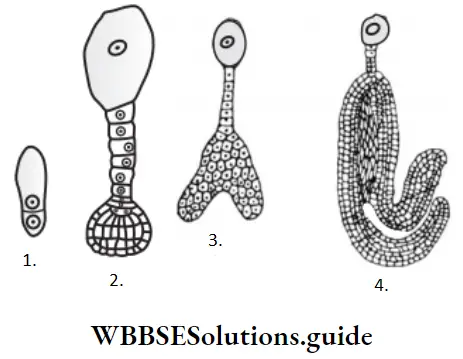
- A–Two-celled stage, B–Heartshaped, C–Globular, D–Mature embryo
- A–Two-celled stage, B–Mature embryo, C–Heart-shaped, D–Globular type
- A–Two-celled stage, B–Globular type, C–Heart-shaped, D–Mature embryo
- A–Mature embryo, B–Heart-haped, C–Globular type, D–Two-celled stage
Answer: 3. A–Two-celled stage, B–Globular type, C–Heart-shaped, D–Mature embryo
A – Two-celled stage B – Globular type embryo C – Heart-shaped embryo D – Mature embryo
Question 30. The embryo in sunflower has
- No cotyledon
- Two cotyledons
- One cotyledon
- Many cotyledons
Answer: 2. Two cotyledons
Sunflower is a dicotyledonous plant. Therefore, the number of cotyledons in the embryo of Sunflower is two.
Biology MCQ For NEET With Answers
Question 31. In a cereal grain, the single cotyledon of embryo is represented by
- Coleoptile
- Coleorhiza
- Scutellum
- Prophyll
Answer: 3. Scutellum
Embryos of monocotyledons possess only one cotyledon. In the context of the grass family (family Gramineae), this is referred to as the scutellum. It is situated towards one side of the embryonal axis.
Question 32. The ephemeral structure which anchors the embryo and pushes it into the nutritional zone of the embryo sac is called
- Haustorium
- Suspensor
- Coleorhiza
- Radicle
Answer: 2. Suspensor
Suspensors or ephemeral structure are anatomical structures found in certain fungi and plants. In higher plants, they are a mass of cells that push the developing embryo down into the nutritive tissues, so that they can obtain the maximum nutrition for further development.
Question 33. Aleurone layer is part of
- Endosperm
- Embryo
- Tegmen
- Testa
Answer: 1. Endosperm
Aleurone layer is proteinaceous endosperm layer found in seeds of families–Graminae and Polygonaceae. The cells of this layer contain aleurone grains which store protein for developing embryo.
Question 34. What is the number of chromosomes in aleurone layer, if number of chromosomes is 10 found in megaspore mother cell?
- 10
- 20
- 15
- None of these
Answer: 3. 15
The number of chromosomes in megaspore mother cell is 10, i.e. 2n = 10. So, n = 5. Haploid number of chromosomes is 5. Aleurone layer is triploid in nature, formed from endosperm nuclei. So, aleurone layer will have 3n = 3 x 5 = 15 number of chromosomes.
Biology MCQ For NEET With Answers
Question 35. Coleorhiza is
- Lower end of embryonal axis in monocot
- Lower end of embryonal axis in dicots
- Lower end of embryonal axis in potato family
- Upper end of embryonal axis in monocot
Answer: 1. Lower end of embryonal axis in monocot
At the lower end of monocotyledonous embryo, the embryonal axis has the radicle and root cap enclosed in an undifferentiated sheath called coleorhiza.
Question 36. Epiblast present in certain monocot embryos represents
- Rudimentary leaves
- Mesocotyl
- Scutellum
- Second cotyledon
Answer: 4. Second cotyledon
- Embryo of certain monocotyledonous seeds contains additional cotyledon besides one present in all monocots. This cotyledon represents the evolutionary stage of cotyledon formation from one to two.
- This second rudimentary cotyledon is not fully developed and it is present as an outgrowth of epiblast.
Question 37. In an embryo, the radicle is near the
- Micropyle
- Chalaza
- Hilum
- Funicle
Answer: 1. Micropyle
- Embryo consists of cotyledon and embryonic axis, the end of the embryonic axis towards micropyle forms radicle. The micropyle is a tiny pore in the testa.
- It admits water to the embryo before active germination. The radicle is the embryonic root which grows and develops into the root system of the plant.
Question 38. Dicot embryo consists of
- Radicle and plumule
- Radicle, plumule, cotyledons and sometimes endosperm
- Radicle, plumule, cotyledons and tegmen
- Radicle, plumule, cotyledons, tegmen and testa
Answer: 2. Radicle, plumule, cotyledons and sometimes endosperm
- A typical dicotyledonous embryo consists of an embryonal axis and two cotyledons. The portion of embryonal axis above the level of cotyledons is the epicotyl which terminates with the plumule.
- The cylindrical portion below the level of cotyledons is hypocotyl that terminates at its lower end in the radicle. Reserved food material is stored in the form of endosperms sometimes.
- Thus, dicot embryo consists of radicle, plumule, cotyledons and sometimes endosperm.
Question 39. Identify the A to E in following
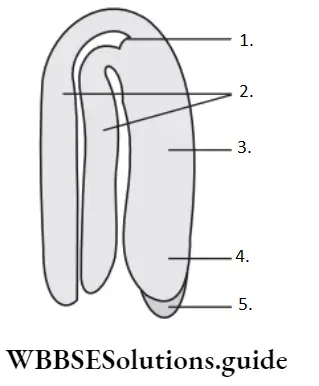
- A–Radicle, B–Root cap, C–Plumule, D–Hypocotyl, E–Cotyledons
- A–Cotyledons, B–Hypocotyl, C–Plumule, D–Root cap, E–Radicle
- A–Hypocotyl, B–Radicle, C–Root cap, D–Cotyledons, E–Plumule
- A–Plumule, B–Cotyledons, C–Hypocotyl, D–Radicle, E–Root cap
Answer: 4. A–Plumule, B–Cotyledons, C–Hypocotyl, D–Radicle, E–Root cap
Biology MCQ For NEET With Answers
Question 40. In this diagram showing the LS of an embryo of grass, identify the answer having the correct combination of alphabets with the right part.
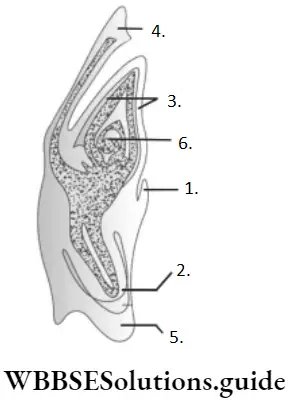
- A–Epiblast, B–Scutellum, C–Coleoptile, D–Radicle, E–Coleorhiza, F–Shoot apex
- A–Root cap, B–Coleoptile, C–Scutellum, D–Coleorhiza, E–Epiblast, F–Shoot apex
- A–Epiblast, B–Radicle, C–Coleoptile, D–Scutellum, E–Coleorhiza, F–Shoot apex
- A–Shoot apex, B–Epiblast, C–Coleorhiza, D–Scutellum, E–Coleoptile, F–Radicle
Answer: 3. A–Epiblast, B–Radicle, C–Coleoptile, D–Scutellum, E–Coleorhiza, F–Shoot apex
Question 41. In which of the following does the germination of the embryo occur when fruit is still attached to the plant?
- Rhizobium
- Rhizoclonium
- Pineapple
- Mangrove plants
Answer: 4. Mangrove plants
Mangrove plants are found in marshy areas and on the sea coast. In viviparous germination, the seeds germinate while still attached to the parent plant. The embryo grows out of the seed and then out of the fruit and projects from it in the form of a green seedling.
Question 42. Dicotyledonous seeds usually store reserve food materials in
- Cotyledons
- Perisperm
- Coleoptile
- Coleorhiza
Answer: 1. Cotyledons
In dicotyledons, the embryo consists of an embryo axis and two cotyledons. Cotyledons are usually fleshy and contain reserve food materials.
Question 43. After fertilisation, the outer integument forms
- Testa
- Tegmen
- Perisperm
- Pericarp
Answer: 1. Testa
After fertilisation, the outer integument forms testa, inner integument forms tegmen and ovary wall forms pericarp.
Question 44. Caruncle is derived from
- Cotyledons
- Integument
- Peduncle
- None of these
Answer: 2. Integument
- Caruncle is a white, collar-like structure borne on the micropylar end of the seed in many members of the family–Euphorbiaceae such as castor.
- The soft outgrowth capping the hard seed is formed by proliferation of the cells at the tip of the outer integument.
Biology MCQ For NEET With Answers
Question 45. Coleorhiza is a cap-like covering over
- Plumule in a dicot
- Radicle in dicot
- Plumule in a monocot
- Radicle in a monocot
Answer: 4. Radicle in a monocot
Coleorhiza is the conical protective sheath which encloses the radicle in a monocot seed. It is the undifferentiated sheath which produces seminal roots to aid in absorption of water.
Question 46. Aleurone layer in maize grain is especially rich in
- lipids
- Auxins
- Proteins
- Starch
Answer: 3. Proteins
Aleurone (from Greek aleuron– flour) is a protein found in protein granules of seeds and tubers
undergoing maturation. The aleurone layer is the outermost layer of the endosperm.
Question 47. Seed coat is not thin and membranous in
- Coconut
- Groundnut
- Gram
- Maize
Answer: 1. Coconut
The seed coat develops from integuments originally surrounding the ovule. It is thick (not thin) and hard in coconut which protect the embryo from mechanical injury and from drying out.
Question 48. The part that separates the embryo region from the endosperm region in the seed of maize is
- Scutellum
- Husk
- Testa
- Hilum
Answer: 1. Scutellum
In the seed of maize, scutellum separates the embryo region from the endosperm region.
Question 49. In hypogeal germination due to elongation of ……………, plumule comes out of the ground.
- Hypocotyl
- Epicotyl
- Cotyledons
- Both 1 and 2
Answer: 2. Epicotyl
- In hypogeal germination due to first epicotyl elongation, plumule comes out of the ground and cotyledons remain underground.
- Hypocotyl does not elongate. This type of germination occurs in most of the monocotyledons and few dicotyledons, e.g. maize, rice, wheat, coconut, gram, pea, peanut, and mango.
Question 50. The seed coat in both gymnosperms and angiosperms is derived from the
- Megaspore
- Microspore
- Megasporangium
- Microsporangium
Answer: 3. Megasporangium
- In angiosperms and gymnosperms, the seed coat is derived from megasporangium or ovule. Seed coat develops from the integuments of the ovule.
- The outer coat is called testa and the inner layer is called tegmen. Two outer layers of integument, i.e. outer fleshy layer and middle stony layer form the seed coat.
Question 51. Which one of the following statements regarding post-fertilisation development in flowering plants is incorrect?
- Ovary develops into fruit
- Zygote develops into embryo
- Central cell develops into endosperm
- Ovules develop into embryo sac
Answer: 4. Ovules develop into embryo sac
Statement in option is incorrect and can be corrected as Embryo sac is not the post-fertilisation product.
Following are the post-fertilisation changes.
- Ovule converted into seed.
- Ovary converted into fruit.
- zygote converted into embryo.
- Central cell converted into endosperm.
Rest other statements are correct.
NEET Biology Mcq Chapter Wise
Question 52. In a seed of maize, scutellum is considered as cotyledon because it
- Protects the embryo
- Contains food for the embryo
- Absorbs food materials and supplies them to the embryo
- Converts itself into a monocot leaf
Answer: 3. Absorbs food materials and supplies them to the embryo
- In the grain of maize, the cotyledon is modified into an organ called scutellum (term came from the Latin word meaning ‘Shield’).
- The food stored in scutellum is used first during germination of seed. Later on, scutellum absorbs the food of endosperm and supplies it to the developing embryo.
Question 53. False fruit is a fruit in which
- Only chalazal cells take part in fruit development
- Only embryo takes part in fruit development
- Only ovary takes part in fruit development
- Other floral parts participate in fruit development
Answer: 4. Other floral parts participate in fruit development
A false fruit is derived from the floral parts other than ovary. It is also called pseudocarp or accessory fruit, e.g. apple and strawberry.
Biology MCQ For NEET With Answers
Question 54. In some plants, thalamus contributes to fruit formation. Such fruits are termed as
- False fruits
- Aggregate fruits
- True fruits
- Parthenocarpic fruits
Answer: 1. False fruits
The fruit that develops from thalamus but not ovary is called false fruit, e.g. cashew nut.
Question 55. Non-albuminous seed is produced in
- Maize
- Castor
- Wheat
- Pea
Answer: 4. Pea
In majority of dicot seeds, including pea, the endosperm is consumed during seed development
and the food is stored in cotyledons and other regions. They are called non-endospermic or exalbuminous seeds.
NEET Biology Mcq Chapter Wise
Question 56. Persistent nucellus in the seed is known as
- Chalaza
- Perisperm
- Hilum
- Tegmen
Answer: 2. Perisperm
Persistent nucellus is called perisperm. It is a layer of nutritive tissue in the seed of certain flowering plants, e.g. black pepper, beet.
Question 57. An example of a seed with endosperm, perisperm and caruncle is
- Coffee
- lily
- Castor
- Cotton
Answer: 3. Castor
An example of a seed with endosperm, perisperm and caruncle is castor. Castor seed is the source of castor oil, which has a wide variety of
uses.
Question58. Albuminous seeds store their reserve food mainly in
- Perisperm
- Endosperm
- Cotyledons
- Hypocotyl
Answer: 3. Cotyledons
An example of a seed with endosperm, perisperm and caruncle is castor. Castor seed is the source of castor oil, which has a wide variety of
uses.
Question 59. The given figure shows LS of the seed of maize. What do A, B, C and D represent?
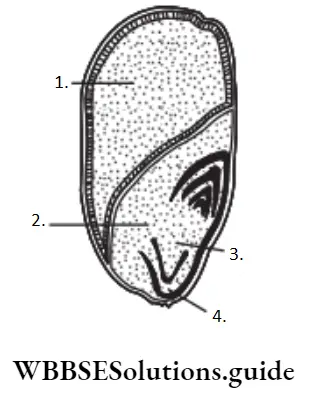
- A–Endosperm, B–Scutellum, C–Plumule, D–Coleoptile
- A–Scutellum, B–Pericarp C–Radicle D–Coleoptile
- A–Endosperm, B–Scutellum C–Radicle, D–Coleorhiza
- A–Scutellum, B–Pericarp, C–Plumule, D–Coleorhiza
Answer: 3. A–Endosperm, B–Scutellum C–Radicle, D–Coleorhiza
NEET Biology Mcq
Question 60. Match the columns representing ovular structure with postfertilisation structure and select the correct option from the codes given below.
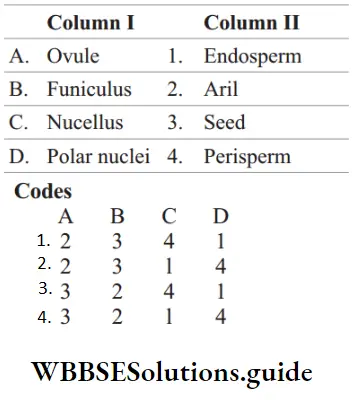
Answer: A–3, B–2, C–4, D–1
Question 61. Assertion Maize is one-seeded fruit with pericarp firmly fused with testa. Reason (R) Hilum and micropyle are not visible in maize seed.
- Both A and R are true and R is the correct explanation of A
- Both A and R are true, but R is not the correct explanation of A
- A is true, but R is false
- Both A and R are false
Answer: 1. Both A and R are true and R is the correct explanation of A
- Maize or corn seed is actually a one-seeded fruit called caryopsis or grain. It is a monocot endospermic seed.
- The seed coat (testa) is fused with the fruit wall (pericarp). Maize seeds consist of seed coat, endosperm and embryo. Thus hilum and micropyle are not visible in maize seeds.
Question 62. Why does seed dormancy occur?
- Due to favourable conditions
- Due to unfavourable conditions
- Due to embryonic conditions
- Due to specific endosperm conditions
Answer: 2. Due to unfavourable conditions
- As seed matures, its water content is reduced and seed becomes relatively dry (10-15% moisture by mass).
- The general metabolic activity of the embryo slows down. The embryo may enter a state of inactivity called dormancy.
- When favourable conditions are available (i.e. adequate moisture, oxygen, suitable temperature) seeds germinate.
NEET Biology Mcq
Question 63. Assertion Scarification is followed for the seeds with thick impermeable seed coats. Reason (R) It is treatment of seeds with strong mineral acids.
- Both A and R are true and R is the correct explanation of A
- Both A and R are true, but R is not the correct explanation of A
- A is true, but R is false
- Both A and R are false
Answer: 1. Both A and R are true and R is the correct explanation of A.
If the seed coat is very hard, seeds will require scarification in order to germinate. Chemical scarification is carried out by keeping the seeds in strong mineral acids like KCl, nitric
acid, sulphuric acid or organic solvents.
Question64. Match the following columns.
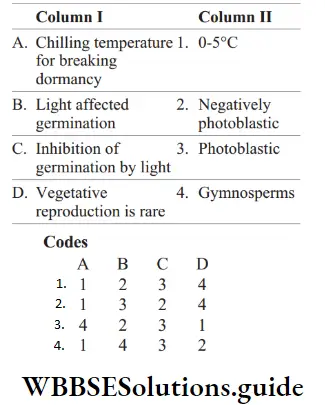
Answer: 2. A–1, B–3, C–2, D–4
Question 65. Essential requirements for seed germination are
- light and CO2
- Water and oxygen
- Water and soil
- Microbes, cold or hot treatment
Answer: 2. Water and oxygen
Conditions necessary for seed germination are water, oxygen, temperature, light or darkness, etc.
NEET Biology Mcq
Question 66. The 2000 year old seed excavated from King Herod’s palace at dead sea belongs to
- Dendrocalamus strictus
- Lupine articuls
- Phoenix dactylifera
- Strobilanthes kunthiana
Answer: 3. Phoenix dactylifera
The 2000 year old viable seed is of the date palm, Phoenix dactylifera discovered during the archeological excavation at King Herod’s place near the dead sea.
Question 67. The viability of seeds is tested by
- 2, 6-dichlorophenol indophenols
- 2, 3, 5 -triphenyl tetrazolium chloride
- DMSO
- safranine
Answer: 2, 3, 5 -triphenyl tetrazolium chloride
The viability of seed is tested by 2, 3, 5 triphenyl tetrazolium chloride. It is often called the quick germination test. The seed is examined for colour change and the result is predicted.
Question 68. Why is vivipary an undesirable character for annual crop plants?
- It reduces the vigour of the plant
- It adversely affects the fertility of the plant
- The seeds exhibit long dormancy
- The seeds cannot be stored under normal conditions for the next season.
Answer: 4. The seeds cannot be stored under normal conditions for the next season.
Vivipary is the condition when seeds are germinated on the plant. It is an undesirable character for annual crop plants because germinated seeds cannot be stored under the normal conditions for the next season.

